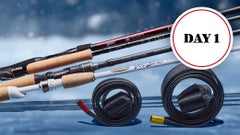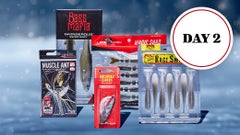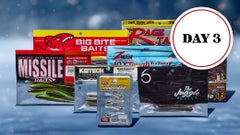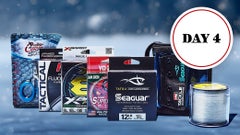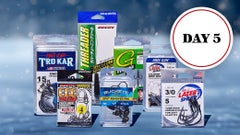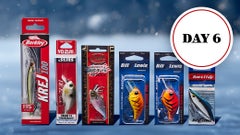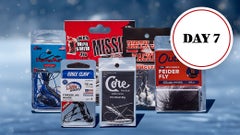Jacob Wheeler Wins BASS Cherokee Lake
Jacob Wheeler's Winning Pattern, Baits & Gear
Wheeler made two pre-practice visits to Cherokee before it went off-limits - one in mid December and the other in early January. He stayed for a week each time. "The reason for that is it was pretty much the only place on the schedule where the fish were going to stay in the same pattern from pre-practice through the tournament," he said. "Very seldom does pre-practice make that much of a difference, but those fish went into their winter pattern when it really cooled down in December and they won't come out of it until about March. "They might not be in the exact same places, but their overall pattern isn't going to change." On both visits he spent the vast majority of his time graphing the lower portion of the lake. By the time he was finished, he'd amassed about 1,600 waypoints. "I marked every place that looked really good - some obvious and some not. If you're just running down the lake and not studying that (Navionics) map, you're not going to see a lot of the subtle changes that could be really important. "I marked rocky places, foundations, road beds that came through a ditch, you name it. I had a different (icons) for rocks that had fish on them and rocks that didn't. For places that were really good, I used a stop sign for like, 'you have to fish here.''' He figures that he investigated about a thousand of his waypoints when he returned for official practice, focusing on the first 11 miles from the dam upstream. Unlike much of the field, he got a bunch of quality bites in practice. "When I told (fellow competitors Adrian Avena and Mark Daniels Jr.) that I got 20 bites on the last day, they were like, 'Dang, you're kidding! You're going to win this thing.' I was like, 'No, I've got a few places, but we'll see."
Competition:
The tournament was pretty much an extension of practice for Wheeler as he bounced around among about 15 places each day to catch 17-pound-plus stringers of smallmouths from 25 to 35 feet of water. He caught most of them on a VMC Neon Moon Eye jig with a small fluke-style trailer, picked up a few on the new Storm 360GT swimbait and added a few more on a Rapala Jigging Rap ice jig. On each day he caught at least two of his weigh-in fish near the dam between 2 o'clock and 3:30. "I don't know if it was current doing it or what, but that's when those fish turned on," he said. "I tried mixing it up a little and on 2 of the days I started the day down toward the dam, but I never could really catch them. "But they always pulled up down there in the afternoon, and when they did they were coming to feed." The only glitch in his program occurred on day 3, when one of his batteries went dead and left him without a trolling motor. Being familiar with the rule allowing anglers to fish from a competitor's boat, he called Daniels, Avena, Andy Montgomery and rookie Dustin Connell to see if he could hitch a ride for the rest of the day. When none answered immediately, he ran a few miles down the lake and found Connell. Wheeler and the B.A.S.S. cameraman accompanying him hopped aboard Connell's boat and Connell's marshal drove Wheeler's boat back to the launch for repairs. The anglers returned to Wheeler's fish - a school that Wheeler described as "a mega-wad," and he upgraded twice prior to the end of the day. The final day got off to a bit of a slow start for him, but a planned move at mid-day resulted in a 12-minute flurry that saw him boat a pair of 4-pounders and three other fish that exceeded 3. He made his last cull for about half a pound when he caught another 4 from near the dam in the closing minutes of the day.
Winning Pattern:
Wheeler said it was critical for him to keep the Moon Eye jig about 2 feet above the heads of the fish (which he could see on his depthfinder). "Smallmouth like to come up to eat, so I'd put it over their head and shake it," he said. "If you dropped it below them, they wouldn't even think about touching it. If it was above them and they were acting funny but not biting, I'd bring it up another foot and sometimes they'd come up and get it. "I'd say it was about 50/50 getting them to bite. Some would come up and slap it or tick it and it was so frustrating that you'd just want to kick your graph." He threw the swimbait at times when the fish seemed averse to a vertical presentation. He had to reel it extremely slow and just off the bottom to entice a bite. He employed the Jigging Rap in a quest to "fire up" schools and ended up weighing one of the handful of fish he caught on it.
Winning Gear:
Jig gear: 7' medium-light Okuma Helios spinning rod, Okuma Helios SX spinning reel, 8-pound Sufix Nanobraid line (main line), 6-pound Sufix Castable Invisiline (8- to 10-foot leader), 3/8-ounce VMC Moon Eye jighead (fathead), unnamed 3-inch soft-plastic trailer (transluscent pearl white).
Swimbait gear: 7' medium-action Okuma Helios casting rod, Okuma Helios TCS casting reel (6.6:1 ratio), 10-pound Sufix fluorocarbon line, 3 1/2-inch Storm 360GT (herring). He used the Jigging Rap in two sizes (5/8- and 7/8-ounce) in the Helsinki shad color.
Main factor: "The time I put in on the water, 100 percent. I put 50 hours on my motor during pre-practice. One day I was out there in the middle of a snowstorm, idling and graphing, and I found one of my main places that day."
Performance edge: "The Sufix Nanobraid is limp and it comes off the spool faster than any other line, and it's great for vertical fishing. It's all about getting down there quicker to stay on top of that fish."
Cherokee Lake Winning Pattern BassFan 2/14/17 (John Johnson)
Jamie Hartman's Pattern, Baits & Gear
Jighead gear: 7' medium-action Cashion spinning rod, Shimano Stradic 3000 spinning reel, 15-pound Hi-Seas braided line (main line), 8-pound Hi-Seas fluorescent green fluorocarbon (10' leader), 3/8-ounce jighead, Damiki Armor Shad (various shad colors).
Main factor: "I'd have to say just persistence and making the right decisions, like changing colors, at the right times."
Performance edge: "My Lowrance graphs. I could not have done it without them."
Jesse Wiggin's Pattern, Baits & Gear
Jighead gear: Unnamed 7'2" medium-action spinning rod, unnamed 2500-size spinning reel, 10-pound Seaguar Smackdown braided line (main line), 6- or 8-pound Seaguar Tatsu fluorocarbon (8' leader), unnamed 3/8-ounce ball-head jig, 3" Jenko Big T Fry Daddy (dirty milk or pearl blue glitter).
Main factor: "Just committing to looking at the graph and idling, and finding a place that had a bunch of fish."
Performance edge: "My Lowrance unit, no question."
Seth Feider's Pattern, Baits & Gear
Jighead gear: 7' medium-heavy Daiwa Steez AGS 10 spinning rod, Daiwa Steez EX 3012 H spinning reel, 10-pound Sufix 832 braided line (main line), 6-pound Sufix Invisiline flurocarbon (12' leader), 3/8-ounce VMC Moon Eye jig, 3" minnow-style soft-plastic trailer (white). He also caught a couple of fish (one that he weighed) on a Rapala Jigging Rap ice jig.
Main factor: "Just having enough places - I could run around some and I had options. Timing was a big deal and sometimes my timing was better than others. Sometimes the fish were biting and sometimes they weren't."
Performance edge: "Definitely my Humminbird graphs - I stared at them for 7 straight days - and my new Minn Kota trolling motor with Spot-Lock."
Paul Mueller's Pattern, Baits & Gear
Jighead gear: 7'2" Dobyns Champion Extreme spinning rod, unnamed 2000-size spinning real, 10-pound Gamma Torque braided line (main line), 6-pound Gamma Edge fluorocarbon (12' leader), hand-poured 3/8-ounce ball-head jighead (from Do-It mold), 3 1/2" Reins Bubbling shaker (bluegill, baitfish or natural pro blue). He threw the under-spin on a 7'6" Dobyns Champion Extreme rod with a Team Lew's Pro Speed spinning reel. He employed 15-pound braid with an 8-pound leader.
Main factor: "I knew I needed to catch a good bag every day after that bad first day, when the cold front moved the bait out of my areas. Once conditions got more stable, the bait moved back in and that brought the (bass) back."
Performance edge: "The Panoptix - it allows you to see everything that's happening away from the boat in real time."















